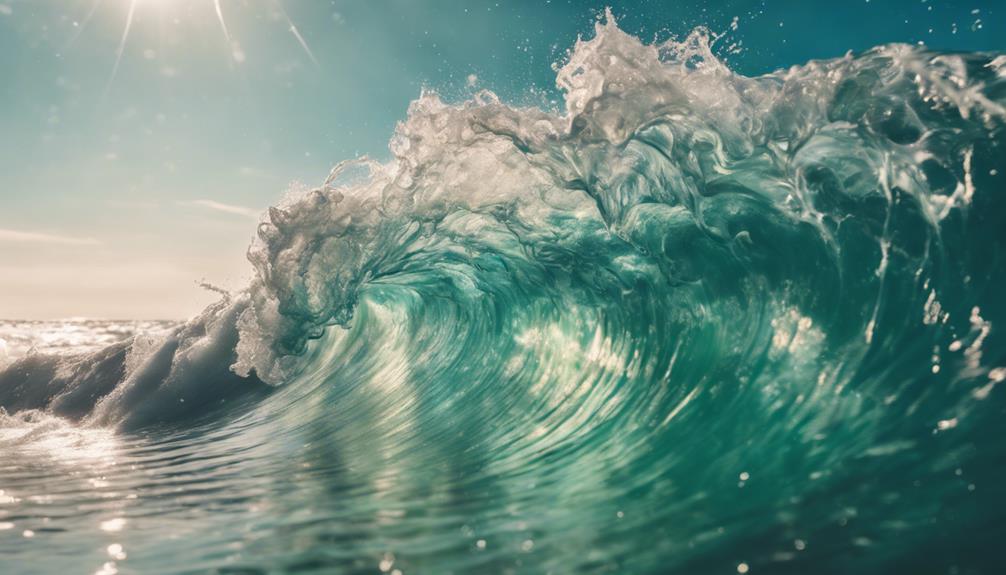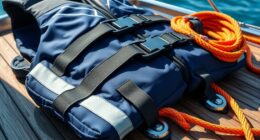Surfing can be exhilarating, but certain waves pose serious risks. Big waves bring the threat of wipeouts and unpredictable currents that can pull you under. Drowning is a real concern, especially in rip currents, where staying calm and swimming parallel to the shore is essential. Marine life encounters, while rare, can be dangerous, so always be aware of your surroundings. Weather conditions can quickly shift, creating hazardous surf. Plus, equipment failures, like broken leashes, can lead to injuries. Knowing these dangers can help you stay safe and confident on the water, and there's even more to discover about protecting yourself.
Key Takeaways
- Drowning risks increase in rip currents; swimmers should remain calm and swim parallel to the shore to escape.
- Big waves heighten impact force and injury risks; unpredictability can lead to wipeouts and underwater struggles.
- Unpredictable wave patterns and sudden weather changes can create hazardous surf conditions, increasing wipeout risks.
- Encounters with marine life, such as sharks, can pose significant threats; awareness of local wildlife is essential for safety.
Drowning Risks in Surfing
When surfing, you need to be aware that drowning risks rise considerably, especially if you get caught in rip currents. These powerful currents can pull you away from the shore and can be overwhelming if you're not prepared. To reduce drowning risks, it's important to be a strong swimmer and comfortable in the open ocean. Panicking only increases your chances of exhaustion, so it's critical to stay calm.
If you find yourself in a rip current, remember the best strategy is to swim parallel to the shore instead of fighting against the current. This approach conserves energy and helps you escape more effectively. Also, don't hesitate to signal for help from lifeguards or fellow surfers if you feel you're in distress.
Being aware of your surroundings and potential hazards can greatly reduce the risks associated with surfing. Understanding ocean conditions and knowing how to respond to emergencies is essential for staying safe. By keeping a clear head and managing your energy, you can enjoy the thrill of surfing while minimizing drowning risks.
Big Wave Hazards

When you tackle big waves, understanding wave energy dynamics is vital.
The risk of wipeouts increases considerably with unpredictable wave patterns, making it essential to stay alert.
Wave Energy Dynamics
Big waves release tremendous energy, creating powerful impacts that can pose serious risks to surfers caught in their path. Understanding wave energy dynamics is vital, especially in locations known for dangerous waves like Nazaré, where unique wave formation patterns amplify hazards.
| Factor | Impact on Surfers |
|---|---|
| Wave Height | Higher waves increase impact force, risking injury. |
| Wave Direction | Unpredictable directions can catch surfers off guard. |
| Rip Currents | Strong currents can pull you under, leading to exhaustion. |
| Underwater Topography | Features like underwater canyons amplify wave size and danger. |
Surfers need to be aware of these factors to navigate safely. XXL waves can lead to situations where you might be held underwater, heightening the risk of drowning. Locations like Jaws and Shipstern Bluff showcase unpredictable wave mechanics, making it essential for you to remain alert and informed. Always keep in mind the dynamics of the surf environment you're entering; it could make the difference between a thrilling ride and a dangerous encounter.
Risk of Wipeouts
Wipeouts in big wave surfing pose significant risks, often resulting in serious injuries due to the immense force and energy of the waves. When you wipeout, especially in XXL conditions, you're faced with waves breaking violently, which can lead to broken bones or other severe injuries, particularly in shallow waters or near reefs.
The danger escalates when closeouts occur, where multiple waves break at once, increasing the likelihood of wipeouts and more catastrophic outcomes. In these challenging environments, duck diving becomes nearly impossible. This leaves you vulnerable in the impact zone, where escape options dwindle.
If you do wipeout, you might find yourself held underwater for extended periods, struggling against powerful currents and the relentless undertow. This battle for breath can lead to exhaustion, making it even harder to recover and reach the surface.
Understanding the risks associated with wipeouts is essential for any big wave surfer. Vigilance and respect for the ocean's power can help you stay safe, but remember, the allure of these dangerous waves always comes with inherent hazards. Stay prepared and aware of your limits.
Unpredictable Wave Patterns
Unpredictable wave patterns can catch even the most experienced surfers off guard, turning a seemingly calm session into a chaotic battle against sudden surges and massive swells. With underwater topography like canyons and reefs, waves can break in ways that are entirely unexpected, leading to hazardous conditions. In spots like Nazaré, Portugal, the waves can exceed 100 feet due to the Nazaré Canyon, making it one of the world's most dangerous surfing locations.
Surfers need to be aware of the following factors when tackling unpredictable patterns:
| Factor | Impact on Surfing |
|---|---|
| Underwater Topography | Can amplify wave height |
| Closeout Waves | Increase risk of wipeouts |
| Strong Winds | Create choppy water conditions |
| Weather Changes | Alter wave formations quickly |
| Distant Swells | Can produce sudden large waves |
Understanding these dynamics is essential for your safety. Always remain vigilant and pay attention to the ocean's changing behavior, as unpredictable breaking waves can turn a fun day into a perilous situation in seconds. Stay safe out there!
Marine Life Threats

Surfers face various marine life threats, including encounters with sharks and venomous creatures like jellyfish and stingrays. While shark activity statistically poses a low risk, the danger escalates in areas known for higher shark populations.
Surfers should be aware that many marine creatures use effective camouflage, making it challenging to spot potential threats in the water. This can lead to accidental encounters, which might result in painful injuries.
Venomous marine life, such as jellyfish and sea urchins, can inflict severe stings, requiring immediate treatment to avoid complications. When you're in the water, keeping an eye on your surroundings is essential.
Familiarizing yourself with local marine life and their behaviors can greatly reduce risks. Additionally, avoid feeding wildlife near surf zones, as it can attract dangerous marine animals.
Environmental Hazards
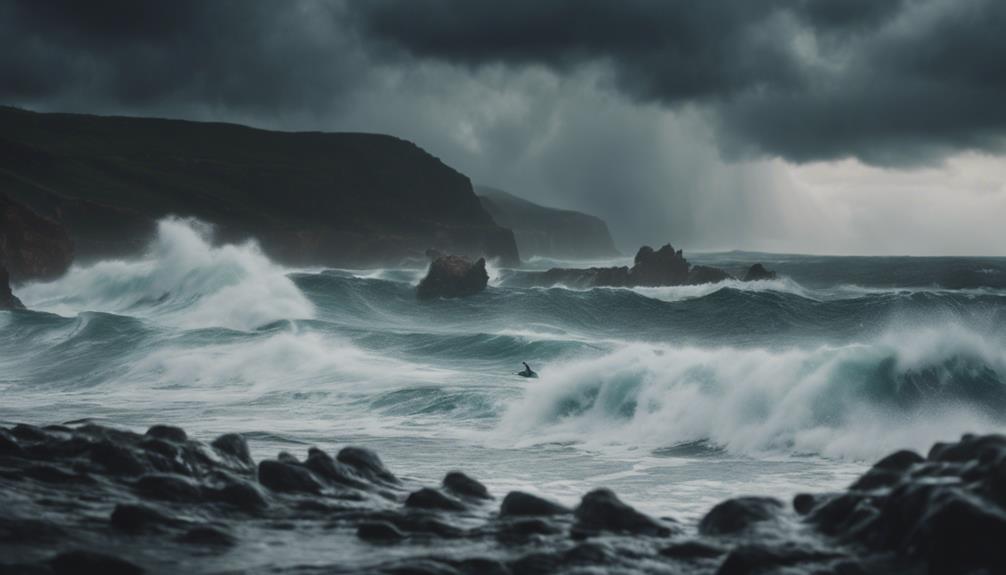
Numerous environmental hazards can threaten your safety and health while surfing, making awareness and precaution essential.
One major concern is pollution in ocean waters. Chemicals, plastics, and sewage can lead to significant health risks, especially after rainfall. It's wise to monitor local water quality alerts to avoid ingesting polluted water, which could lead to serious health issues.
Additionally, be cautious of strong currents, particularly near river mouths. These powerful flows can sweep you away from shore, increasing the risk of drowning. Always assess the water conditions before paddling out, and if currents appear strong, consider waiting for calmer waters.
Beach erosion is another environmental hazard you should be aware of. It can create unstable footing, making it difficult to maintain your balance while entering or exiting the water. Changes in beach conditions can occur rapidly, so stay alert and adapt to the environment.
Equipment and Surfboard Risks
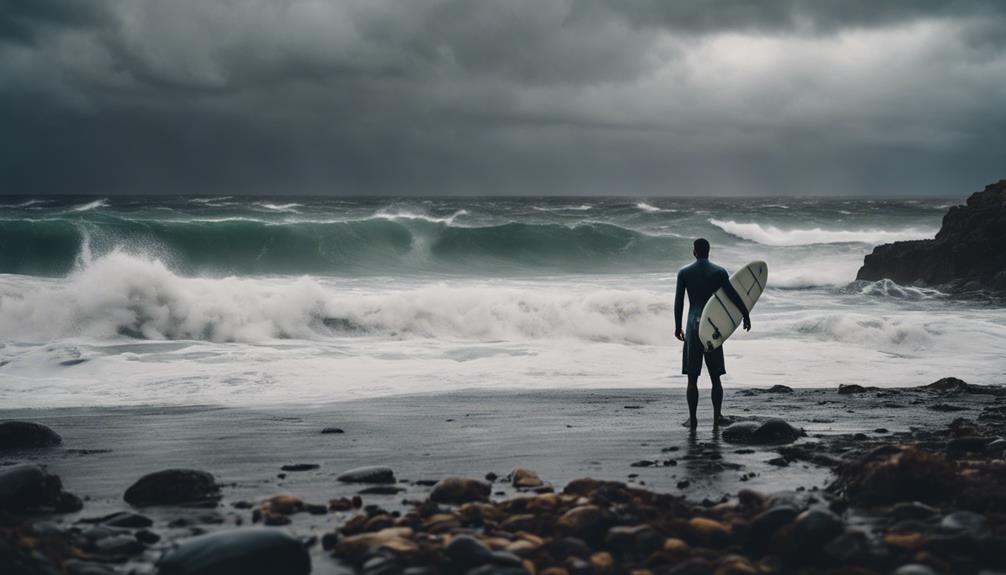
Understanding equipment and surfboard risks is fundamental for guaranteeing your safety while enjoying the waves. Surfboards are your primary tool, but they can also become dangerous projectiles during wipeouts, posing risks not only to you but also to others around you. Sharp fins and noses can cause cuts and injuries, especially if you fall or collide with your board.
Regular maintenance of your surfboard is essential to minimize these risks. Check for cracks and verify that the fins are secure before each session. A broken or damaged leash can lead to entanglement or loss of your board, increasing the likelihood of accidents in the water. Worn-out or poorly maintained surfboards can greatly affect both performance and safety, making it important to conduct thorough inspections.
Always remember that your safety relies not just on your skills but also on the condition of your equipment. Taking a few moments to confirm your surfboard is in top shape can prevent serious injuries and allow you to focus more on enjoying your time in the ocean. Prioritize maintenance and be aware of the potential risks to make the most of your surfing experience.
Weather Conditions Impact
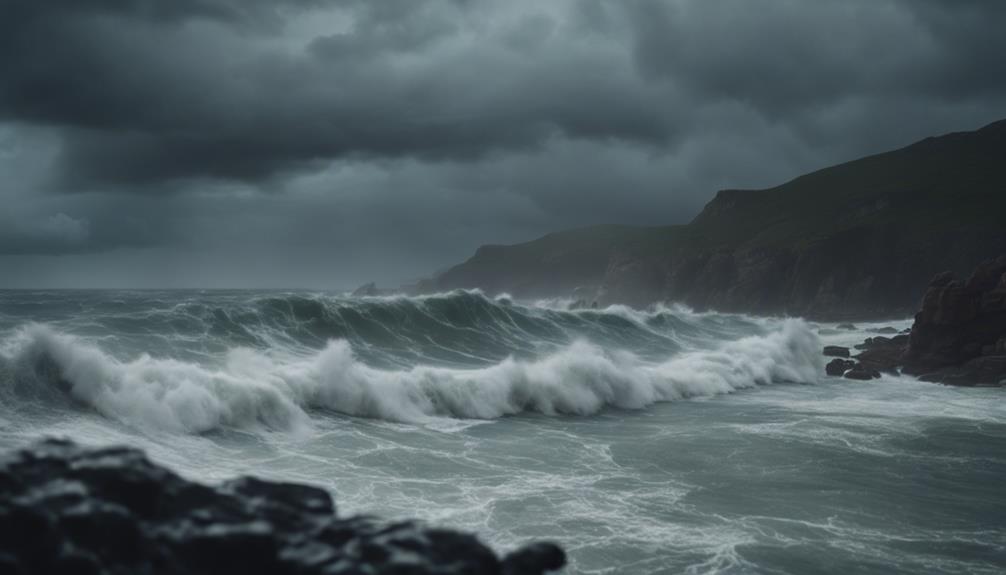
While maintaining your surfboard helps reduce risks, being aware of shifting weather conditions is just as important for your safety in the water.
Sudden storms can create dangerously large waves, making big wave surfing even more perilous. You need to be vigilant; unpredictable currents can quickly turn a fun session into a deadliest scenario.
Strong winds can churn the water, creating choppy conditions that impair your ability to control your board. This unpredictability can lead to wipeouts or collisions. Additionally, if thunderstorms roll in, you should exit the water immediately due to the significant threat posed by lightning.
Fog can also be deceptive, as it severely reduces visibility, increasing the chances of accidents with other surfers or nearby watercraft.
To stay safe, you must monitor local weather forecasts before heading out. This proactive approach allows you to avoid hazardous conditions and enjoy a safer surfing experience.
Localism and Surf Etiquette

Local surfers often exhibit aggressive behavior toward outsiders, especially in crowded spots where competition for waves is fierce. This phenomenon, known as localism, can make your surfing experience uncomfortable if you're not mindful of surf etiquette. To navigate these situations successfully, it's crucial to respect the local customs and the surfers who frequent the area.
Understanding the informal codes of conduct helps guarantee everyone has a safer time in the water. For instance, prioritize who's closest to the peak of incoming waves, and remember to take turns when catching waves.
Communicating your intentions clearly—like signaling when you're going for a wave—can also prevent misunderstandings and potential confrontations.
Inexperienced Surfer Safety
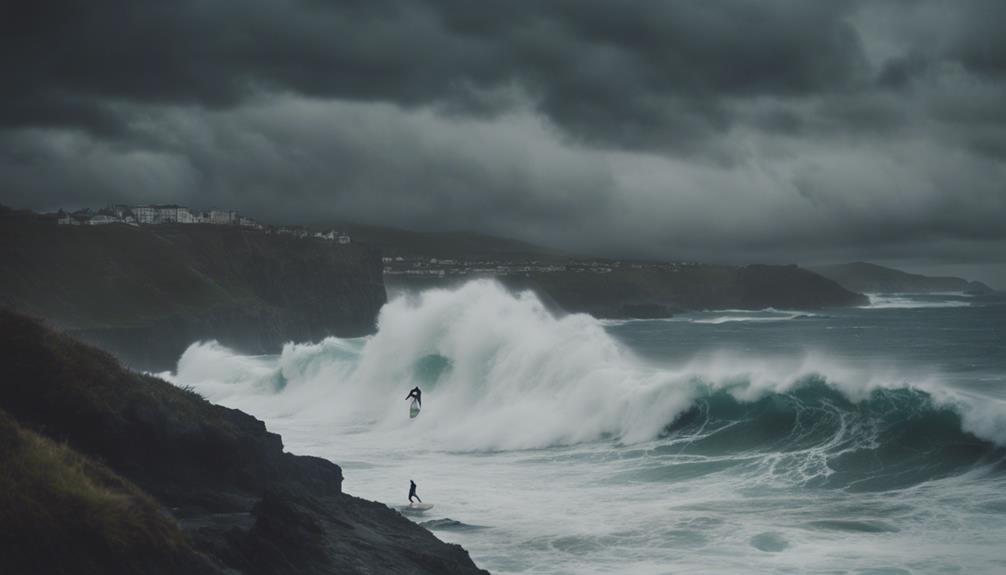
Inexperienced surfers face unique challenges that can put their safety at risk in crowded waters. When you're just starting, your lack of experience may disrupt others, increasing the chances of accidents and collisions. It's vital to familiarize yourself with surf rules and local etiquette to avoid misunderstandings that could escalate with more seasoned surfers.
To mitigate these risks, consider enrolling in surf schools. They provide essential training that teaches you fundamental skills and safety protocols necessary for a safer surfing experience. Learning from professionals can accelerate your confidence and competence in the water.
Additionally, implementing a buddy system among inexperienced surfers can enhance safety. Having someone watch your back can make a significant difference if you find yourself in trouble. Never hesitate to ask for help or clarification from more experienced surfers or lifeguards, as they're valuable resources for identifying safe surfing areas and can assist in emergencies.
Sun Exposure Risks
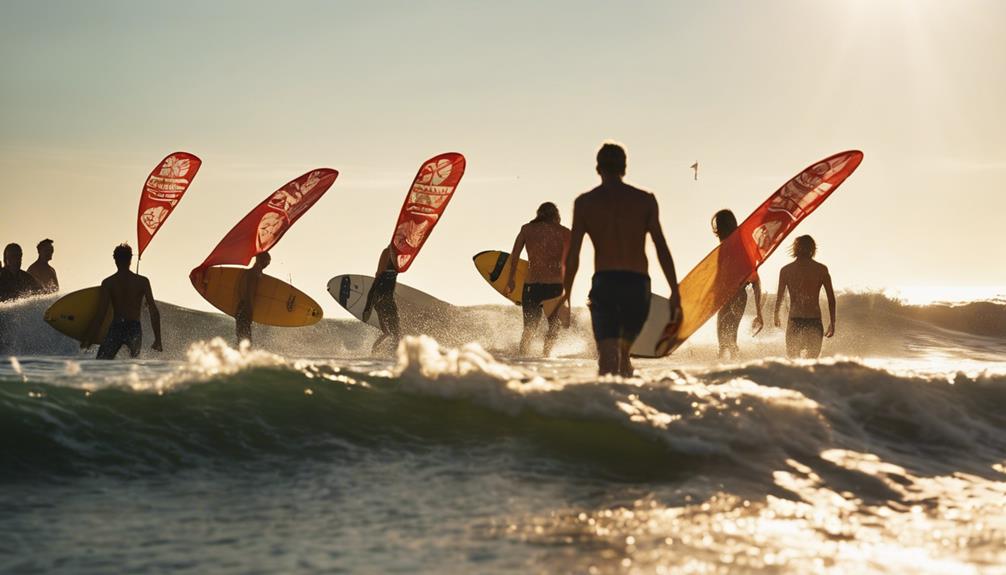
Surfing not only presents hazards from the waves and other surfers but also exposes you to considerable risks from the sun's harmful rays. Prolonged sun exposure while riding the waves increases your vulnerability to skin cancer, particularly during peak UV radiation hours. Tanning is a clear sign of skin damage, and you should avoid it at all costs.
To protect yourself, using high-SPF, reef-safe sunscreen is vital. Remember to reapply it every two hours or immediately after swimming. Additionally, wearing protective clothing like rash guards or wetsuits can considerably minimize skin exposure.
Here's a quick overview of sun exposure risks and protective measures:
| Risk/Measure | Description |
|---|---|
| Sun Exposure | Increases risk of skin cancer and damage. |
| UV Radiation | Highest during midday; be cautious. |
| Reef-Safe Sunscreen | Necessary for protection; reapply regularly. |
Stay aware of UV exposure levels, especially when the sun's intensity peaks. Taking these precautions can help guarantee you enjoy your surfing experience without compromising your health.
Frequently Asked Questions
What Is the Most Dangerous Wave to Surf?
When you consider dangerous waves, it's essential to evaluate conditions like height, break type, and reef exposure. Your choice will vary based on your skill level, but always prioritize safety above adrenaline.
What Type of Wave Is Most Commonly Hazardous to Body Surfers?
Shorebreak waves are the most commonly hazardous for body surfers. They crash directly onto the sand, increasing the risk of serious injuries, especially when conditions are steep or during high surf. Always check local surf forecasts.
Which Waves Are the Most Dangerous and Why?
Did you know that over 100 surfers get injured annually at just one infamous spot? Waves like Banzai Pipeline and Nazaré pose severe risks due to their powerful breaks, sharp reefs, and unpredictable conditions that challenge even the best surfers.
What Wave Height Is Dangerous for Surfing?
Waves over 6 feet can be dangerous for you, especially if you're inexperienced. At 10 feet, risks increase considerably. Heights above 15 feet present severe hazards, making it essential to know your limits and stay safe.
What Makes These Surfing Waves Considered the Most Dangerous?
Surfers around the world consider the most dangerous surfing waves as a thrilling challenge. These waves are notorious for their powerful force, massive size, and unpredictable behavior. They can break bones, cause serious injuries, and even be life-threatening. Surfing these waves requires advanced skills, experience, and a deep understanding of the ocean.
Conclusion
Surfing can be thrilling, but it's essential to respect the ocean and its hazards.
Did you know that around 10% of surfers report having a near-drowning experience? That's a staggering number, highlighting the importance of being prepared and aware.
Whether it's big waves, lurking sea creatures, or unpredictable weather, every surf session carries risks.
Stay informed, prioritize safety, and enjoy the waves responsibly.
After all, the ocean is as beautiful as it's dangerous.





